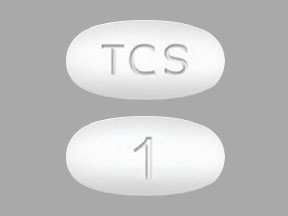Envarsus XR Dosage
Generic name: TACROLIMUS 0.75mg
Dosage form: tablet, extended release
Drug class: Calcineurin inhibitors
Medically reviewed by Drugs.com. Last updated on Feb 26, 2025.
Important Administration Instructions
- ENVARSUS XR (tacrolimus extended-release tablets) is not interchangeable or substitutable with tacrolimus extended-release capsules, tacrolimus capsules, and tacrolimus for oral suspension. Under or overexposure to tacrolimus may result in graft rejection or other serious adverse reactions. ENVARSUS XR should not be used without the supervision of a physician with experience in immunosuppressive therapy.
- ENVARSUS XR should be taken on an empty stomach consistently at the same time of the day, preferably in the morning to ensure consistent and maximum possible drug exposure, at least 1 hour before a meal or at least 2 hours after a meal.
- Advise patients to swallow ENVARSUS XR tablets whole with fluid (preferably water); patients must not chew, divide, crush or dissovle the tablets.
- If a dose is missed, instruct the patient to take it as soon as possible within 15 hours after missing the dose. Beyond the 15-hour time frame, instruct the patient to wait until the usual scheduled time to take the next regular daily dose. Instruct the patient not to double the next dose.
- Patients should avoid eating grapefruit or drinking grapefruit juice or alcoholic beverage while taking ENVARSUS XR.
Dosing in De Novo Kidney Transplant Patients
The recommended starting dose of ENVARSUS XR in de novo kidney transplant patients is 0.14 mg/kg/day. Titrate ENVARSUS XR dosage based on clinical assessments of rejection and tolerability and to achieve whole blood trough concentration ranges (see Table 1).
| Time Period Post Transplant | Target Tacrolimus Whole Blood Trough Concentration Ranges |
| During Month 1 | 6 to 11 ng/mL |
| > Month 1 | 4 to 11 ng/mL |
Dosing for Conversion from Tacrolimus Immediate-Release Formulations
To convert from a tacrolimus immediate-release product to ENVARSUS XR, administer ENVARSUS XR once daily at a dose that is 80% of the total daily dose of the tacrolimus immediate-release product. Monitor tacrolimus whole blood trough concentrations and titrate ENVARSUS XR dosage to achieve whole blood trough concentration ranges of 4 to 11 ng/mL.
Dosing Adjustments in African-American Patients, Patients with Hepatic Impairment, Drug Interactions
African-American patients, compared to Caucasian patients, may need to be titrated to higher ENVARSUS XR dosages to attain comparable trough concentrations.
Due to reduced clearance and prolonged half-life seen in patients with severe hepatic impairment (Child-Pugh ≥10) these patients may require a lower starting dosage of ENVARSUS XR.
Dose adjustments of ENVARSUS XR may be necessary when administered concomitantly with CYP3A inducers or CYP3A inhibitors or cannabidiol.
Therapeutic Drug Monitoring
Measure tacrolimus whole blood trough concentrations at least two times on separate days during the first week after initiation of dosing and after any change in dosage, after a change in co-administration of CYP3A inducers and/or inhibitors or cannabidiol, or after a change in renal or hepatic function. When interpreting measured concentrations, consider that the time to achieve tacrolimus steady state is approximately 7 days after initiating or changing the ENVARSUS XR dose.
Monitor tacrolimus whole blood trough concentrations using a validated assay [e.g., immunoassays or high-performance liquid chromatography with tandem mass spectrometric detection (HPLC/MS/MS)]. The immunosuppressive activity of tacrolimus is mainly due to the parent drug rather than to its metabolites. Immunoassays may react with metabolites as well as the parent drug. Therefore, whole blood tacrolimus trough concentrations obtained with immunoassays may be numerically higher than concentrations obtained with an assay using HPLC/MS/MS. Comparison of the whole blood tacrolimus trough concentrations of patients to those described in the prescribing information and other published literature must be made with knowledge of the assay method(s) employed.
Frequently asked questions
More about Envarsus XR (tacrolimus)
- Check interactions
- Compare alternatives
- Pricing & coupons
- Reviews (2)
- Drug images
- Latest FDA alerts (2)
- Side effects
- During pregnancy
- FDA approval history
- Drug class: calcineurin inhibitors
- Breastfeeding
- En español
Patient resources
Other brands
Professional resources
Other brands
Related treatment guides
See also:
Further information
Always consult your healthcare provider to ensure the information displayed on this page applies to your personal circumstances.


